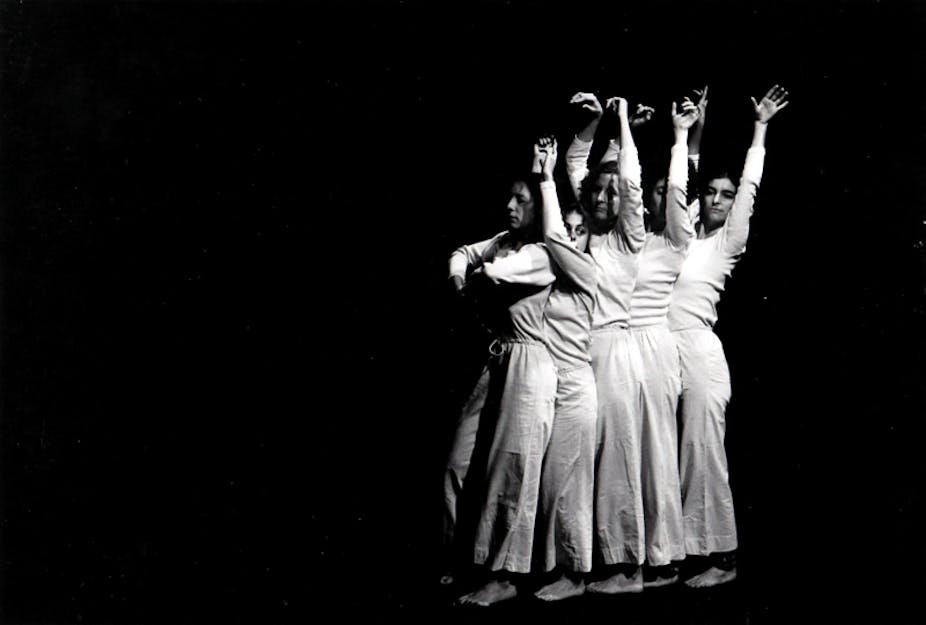A retrospective of the work of American choreographer Trisha Brown (1936-) will be presented at the Melbourne Festival this month. In the performance Early Works, we will have a chance to revisit this experimental historical period of postmodern dance and appreciate how these works were composed.
In the 1960s in New York City, Brown was a member of the infamous Judson Church dance group, a loosely affiliated troupe of dancers, visual artists and musicians who began to experiment with chance or task-driven performance events.
Rejecting the virtuosic abstraction of choreographers such as Merce Cunningham, or the expressive emotion of earlier modern dancers, this group experimented with more diverse bodily practices, such as martial arts training, and new forms of improvisational structure for making movement.

In Brown’s signature work, Accumulation (1971), a dance based on repeating hand-gestures that lead into strange sideways steps and turns, the choreographer recounts a long and rambling autobiographical narrative.
Each action and each part of the story is seemingly inconsequential. The first gesture is composed from bent elbows, maybe a hitch-hikers’ fist held out in front, and the rotation of both wrists.
The movements grow in complexity, one hand veering off in another direction, the hips starting to rotate while the voice continues slowly to tell us about her father, about making the dance, or whatever else comes into consciousness.
Initially a four-and-a-half minute solo (perhaps a tribute to American composer John Cage) and performed in silence to the music of the Grateful Dead, it later became a long dance with talking, and it has also been performed by multiple dancers.
This piece exemplifies many of the peculiar features of American postmodern dance – minimalism, seriality, randomness, dancing with talking, and the disturbance of spectacle.
But Brown has made a unique contribution to this field of choreography with her rigorous methods of composing dances, based often on drawings that reposition shapes within dynamic spatial coordinates.
Brown took to the walls and rooftops of the downtown area of Manhattan. She directed her dancers to walk vertically down apartment blocks and in another event, to send choreographic signals like semaphores across the skyline.

In addition to recognising how phrases are combined and layered, one might also sense a fluid inner patterning in the dancers. I always find their feet pretty fascinating; they are barefoot but use the floor to build a momentum that uses gravity and peripheral awareness rather than outwardly directed gestures.
The legacy of this movement style lives on in many Melbourne choreographers who utilise various forms of “release” – such as Skinner Releasing Technique – to loosen up their bodies for dancing, but few of them have the consistent rigour, politics and eloquence of Brown’s work.
Another work featured in Melbourne is called Spanish Dance (1973) and was later part of a longer piece, Line Up (1976). Performed to the nostalgic tunes of Gordon Lightfoot’s song Early Morning Rain sung by Bob Dylan, five female dancers shuffle across the stage, eventually snaking into a line one behind the other. As Lisa Kraus, one of the original performers, explains on her blog:
It was a dance for all women, simply and uniformly clad, strong and smart but reflecting the non-heroic performer ethos of its time. Its virtuosity was brainy rather than flashy; its tongue-in-cheek wit a fresh breeze.
The pleasure, and perhaps joke, of this dance is that one woman shuffles into another so that crotch cupped in crotch, knees bending at the same time, they move like a pulsing train.
With a great deal of seductive languor, they slowly but surely lift their arms in unison over their heads as they find “their sultry siren selves” (see main image). The choreography thus replaces the ego-eroticism of the male flamenco dancer and the self-pity of the song by transforming it into a feminist jouissance – an expression of sexual pleasure.

Today, Brown’s choreography is being shown in art galleries – Documenta (2007), Barbican (2011), MOMA NY (2011), Tate Modern (2010) – as if it is really now a museum exhibit.
In those contexts, as with the title of the festival evening, Pure Movement, Brown’s longstanding investigation of a traditionally “modernist” purity in line and structure is reframed and celebrated.
Brown’s radical legacy, however, lies in the subtle and playful differences that were built from repeating and inventing new planes for embodiment with her dancers back in the 1960s and 70s.

